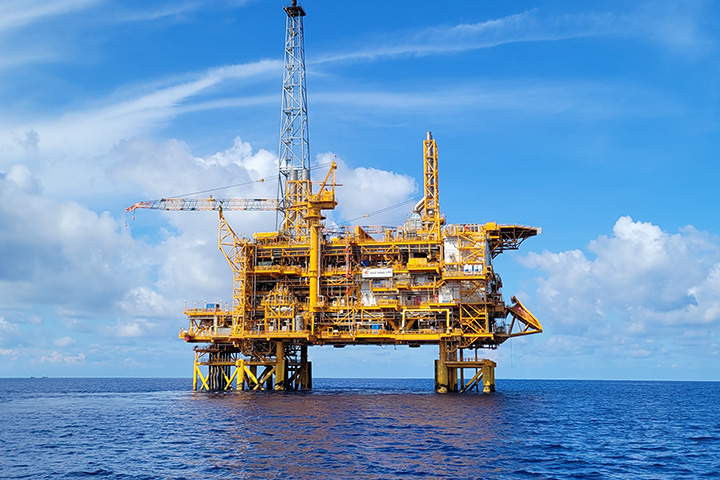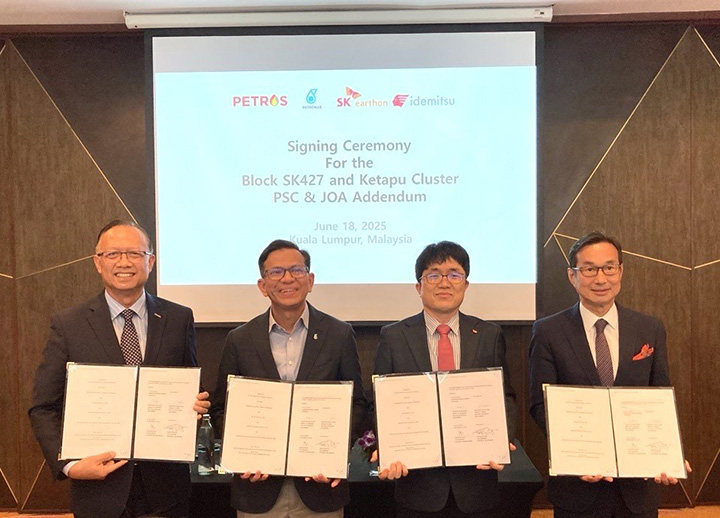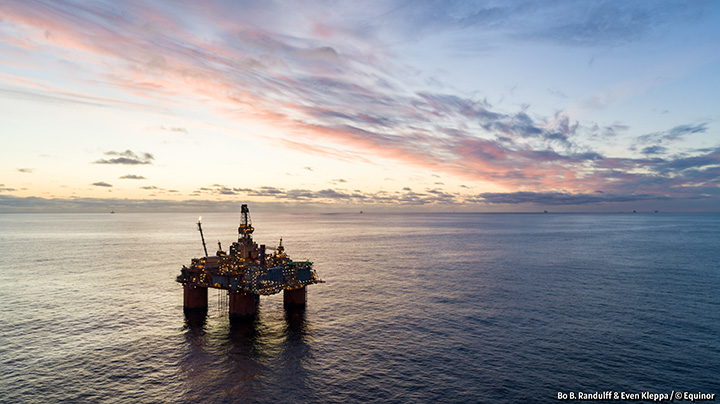



2025.06.19
Entry into oil and gas blocks for exploration and development in Malaysia! Acceleration of upstream business in Southeast Asia by consolidating experience in Norway and Vietnam

Central Production Platform at the Sao Vang Gas Field, Vietnam
Southeast Asia, an area undergoing remarkable economic growth. For the further development of the surrounding area, a stable supply of energy to support the growing demand for electricity is essential. We have entered the exploration and development business by acquiring interests of two blocks located off the coast of Sarawak, Malaysia. Currently, we are engaged in oil and natural gas upstream business in Norway and Vietnam as our main focus areas. We expects that this acquisition will accelerate the establishment of new core area to be commercialized in Southeast Asia by advancing the knowledge and experience accumulated to date.

Contract signing ceremony for the exploration and development project in Malaysia
What is oil and natural gas development?
What kind of image do you have in “oil and natural gas development”?
Oil and natural gas are used worldwide for a variety of purposes, including fuel for automobiles and thermal power generation, raw materials for plastic products, and city gas for home use. Oil and natural gas are generated when the remains of ancient organisms decompose and mature in geological strata; the resultant liquid form is called oil and the gaseous form is called natural gas. In general, oil and natural gas reserves are often in a mixed state, and are called “oil fields” if the reserves are oil-rich, “gas fields” if the reserves are natural gas-rich, or “oil and gas fields” if both are present.
Oil and natural gas are used worldwide for a variety of purposes, including fuel for automobiles and thermal power generation, raw materials for plastic products, and city gas for home use. Oil and natural gas are generated when the remains of ancient organisms decompose and mature in geological strata; the resultant liquid form is called oil and the gaseous form is called natural gas. In general, oil and natural gas reserves are often in a mixed state, and are called “oil fields” if the reserves are oil-rich, “gas fields” if the reserves are natural gas-rich, or “oil and gas fields” if both are present.
Oil and gas field development begins with the discovery of “oil and natural gas” lying underground. Once it is determined that there is a possibility of presence of economically sufficient reserves for the project, we proceed carefully through the following stages: “acquisition of interests in block” to acquire the rights to conduct exploration through production as follows, “exploration” to confirm the presence of sufficient oil and gas for development, “development” to study production methods and construct facilities, then “production” to conduct production operations. Therefore, commercialization takes a long time and requires a large amount of capital expenditures beforehand. Generally, it takes about ten to twenty years and tens to hundreds of billions of yen from the consideration of acquiring a block to the start of production. In addition, even if you are able to acquire an interest in a prospective block, it does not necessarily mean that you will be able to succeed in reaching the production stage. Therefore, it is necessary to bring together not only specialists with technological knowledge in geosciences and resource related engineering, but also specialists in public relations, finance, legal affairs, and general affairs for negotiations and coordination with the government, local governments, and project partners, as well as for project management.

Idemitsu Kosan’s challenge, expanding overseas from the Sea of Japan
We have a history of oil and natural gas development spanning more than 60 years, dating back to its participation in a block tender in Iran in the late 1950s. In 1966, we applied for prospecting rights to the continental shelf of the Sea of Japan, marking its full-scale entry into oil exploration and development. Subsequently, in 1972, we succeeded in producing oil for the first time 15 km offshore of Niigata City’s East Port, and in 1976, production began at the Aga-Oki Oil and Gas Field as Japan’s first full-scale offshore oil and gas field. In 1984, we began production in the Aga-oki Kita Oil Field off the coast of Niigata City. Twenty-one engineers with expertise and knowledge in handling crude oil were dispatched from refineries to develop the Aga-oki Kita Oil Field, and we materialized the development and production by ourselves.

Offshore production processing facility at the Snorre Oil Field, Norway
Currently, we have moved main activities to overseas and are conducting oil and gas exploration and production projects in Norway and Vietnam. In Norway, starting with the acquisition of interests in the Snorre Oil Field in 1989, we became the first Japanese company to participate in oil field development in the North Sea, gaining experience in upstream technology and management, where exploration activities together with stable production operations continue today. In Vietnam, exploration activities began in the 1990s, eventually production starting in Sao Vang Gas Field in 2020 and Dai Nguyet Gas Field in 2022. In the local language, “sao vang” means “gold star” and “dai nguyet” means “big moon.” These gas fields in Vietnam are our first overseas operator projects that have successfully progressed from exploration phase to production stage. An operator is a party to a project that takes full responsibility of implements and manages entire oil and gas field operations through exploration, development, production and abandonment on behalf of its partners. We have assembled and managed teams of specialists from around the world with a wide variety of expertise, and have led projects with multinational members. Produced natural gas is transported through submarine pipelines to a group of power plants about 300 km away to support Vietnam’s electricity demand.
The operator projects in Vietnam have truly blossomed from the knowledge and experience, relationships with partners, and accumulated operational know-how gained from our past challenges, including business development in the Sea of Japan and Norway. And we will carry forward this experience to this project off the coast of Sarawak, Malaysia. In the future, while fulfilling our responsibility to provide a stable energy supply, we will contribute to reducing the environmental impact of the power supply combining by shifting from coal-fired to gas-fired power generation, and we are also actively attempting and pursuing carbon-neutral initiatives, including CCS*, using this project as a foothold.
*Carbon Capture and Storage: Technology for separating and capturing CO2 contained in exhaust gases from power plants and other sources, and storing it safely underground.


 return
return